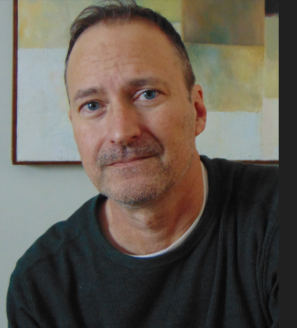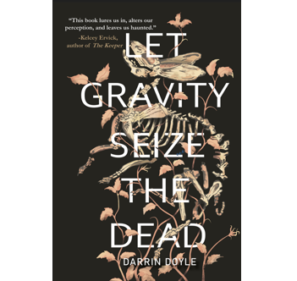
Darrin Doyle
Interview with Darrin Doyle,
author of Let Gravity Seize the Dead
Darrin Doyle’s new novella, Let Gravity Seize the Dead (coming on July 9th from Regal House Publishing) casts a spell from its first pages, drawing readers ever deeper into its mind-bending world, right up to its shattering, revelatory ending.
A central character in the novella is Beck Randall, who has moved his family from the city to a cabin in the Michigan woods, seeking to make a new life. Beck’s ill-fated great-grandfather helped build the cabin, and died soon after the construction was completed. This is just part of the homestead’s dark past, which has become the subject of rumors in the nearest town. But this past remains shrouded in mystery for Beck, his wife, and their two daughters, Lucy and Tina.
The novella’s woodland setting isn’t the least bit peaceful. The earth and trees seem to hum with malevolent truths. Then there’s an unsettling whistling that certain characters hear now and then, a whistling tied to troubling family lore and ill portents. It turns out that the younger daughter, Tina, is especially attuned to these signs and signals, which evolve into a force of their own over the course of the novella, bending and shaping reality and bringing dark truths about her family’s past to light.
With lyrical and haunting prose, Doyle conveys how a landscape can absorb and even embody malevolence, laying traps for the unsuspecting or curious. He has crafted a novella as spellbinding as it’s terrifying, one that Small Press Picks highly recommends.
 Recently, Beth Castrodale of Small Press Picks had the pleasure of interviewing Doyle about Let Gravity Seize the Dead.
Recently, Beth Castrodale of Small Press Picks had the pleasure of interviewing Doyle about Let Gravity Seize the Dead.
BC: There is such a strong and haunting sense of place in this novella. Did the place come to you first, or did it take shape as you developed your characters and their stories?
DD: The setting definitely came first. For the past number of years I’ve been doing writing in isolated, wooded areas, and I finally decided that I needed to make it the central setting for a scary, atmospheric story. I’ve always loved the peace and beauty of the forest, and yet I’m also aware that it carries a sort of primal fear for me and for most people, so it’s a great place to explore those contrasting forces.
The characters and their stories developed alongside the setting; I tried to make the nature into another character in the book – one that pushed, challenged, and inspired the human characters in different ways. In fact, nature in the novella is something like a conduit, a carrier of the past traumas that the family has experienced.
BC: Did you have a story arc in mind from the start, or did you discover the direction of the novella as you wrote?
DD: Two images kicked off the story for me: a winding, bumpy, one-lane dirt road that cuts through dense woods, leading to a cabin in a clearing; and secondly, a mysterious whistling that rings through the forest at night. I only knew that I wanted to create something spooky and horrifying, with a Gothic vibe. Then I planted a conflict: a couple with two teenage daughters has abruptly decided to re-locate their lives to this isolated place.
I’m the kind of writer who doesn’t plan very much in the initial stages. I generate characters, create tension, atmosphere, and voice, and then discover where these elements might lead. I like to surprise myself. For this approach, I think it’s important to continue to escalate the stakes and never let the characters feel too comfortable.
BC: This novella is deeply terrifying, especially on a psychological level. In your view, what are some elements that make a horror tale compelling?
DD: I hear the terms “likeable” or “unlikeable” characters, but in my mind what matters most is whether the characters come across as 3D human beings. To that end, I try to give characters complex motives, fears, desires, strengths, weaknesses, and so on. The hope is that these people will earn the reader’s empathy, and once we empathize with them, then we’ll feel whatever they’re feeling (in this case, terror).
But horror should also have things that go bump in the night, images and events that give you chills. That’s why setting is so crucial – I mentioned before that the woods tap into primal human fear – so painting a dark, threatening atmosphere can create a pervasive mood of dread and unease.
I also love the uncanny, which is a feeling that comes when familiar, comfortable things are presented to us as unfamiliar, strange, or unsettling. For example, there’s a black rabbit in my story that may or may not have human teeth. There are noises in the forest like a creaking tree that cries like an infant. The tarps on the windows of the unfinished cabin flap in the night breeze “like flightless birds.” Imbuing the world with properties that conjure uncanny feelings – that’s what I enjoy. Ghosts and possession are other examples of the familiar returning in unfamiliar forms, and this story has both.
BC: I love the contrasting perspectives of the two daughters in the novella. Lucy, the older daughter, feels completely trapped and stunted by her family’s move to the woods, while Tina seems intrigued by the woodland setting and the way it unleashes her imagination. This contrast feels true both to typical sibling dynamics and to the tension in the novella between what’s real and what’s conjured or imagined. Can you say a bit about what the sisters’ relationship means to you as a writer, or about how the relationship evolved during your writing process?
DD: Putting characters in opposition to each other is a great way to create conflict, so I always like forcing opposite personalities to interact. Conflicts are a perfect engine for any story. And fighting siblings seemed pretty realistic in this situation. As you mentioned, Lucy is the older sister, age 16, and it made sense to me that she would resent being pulled away from her friends, her social life. Tina, on the other hand, who is not quite 13, is not only less set in her social life but stands on that boundary between childhood and adulthood. She’s still holding onto the openness and imagination of a child, which exposes her to the possibilities of the supernatural, the past intruding on the present. Tina is definitely a catalyst in the book, an agitator whose curiosity brings the darkness home. I think she sees the ghosts of the past as a loving presence, and she longs to bring them all together – not understanding that this union can never be possible since the ghosts probably aren’t actually the deceased relatives but instead are a residual pulse tainted by trauma, a whistle in the dead of night.
BC: Have any particular books, writers, movies, or other media inspired your writing, especially the supernatural aspects of it? What did you draw from these influences?
DD: Shirley Jackson and Edgar Allan Poe, who approach horror and the supernatural through the psychologies of their characters, have been influences for many years. Kathryn Davis’s novel Hell features multiple timelines and lots of grotesque imagery and was also a big influence. Paul Theroux’s The Mosquito Coast is a novel with incredible nature descriptions, so I looked to that book for inspiration. I love horror movies, too, and directors like Ari Aster, David Lynch, Jennifer Kent, David Cronenberg, and Oz Perkins have long been filling me with creepy, nightmarish ideas.
BC: What writing projects are you working on now?
DD: I’ve got another horror-ish novella that’s mostly complete (I hope), and then another novella that’s in the middle stages of being written. The completed one is set primarily in the 1960s and ‘70s in Flint, Michigan. There are occult rituals, curses, human sacrifices, a B-movie schlock horror producer – all of that good stuff.
BC: Is there anything else you’d like readers to know about the novella or your process of writing it?
DD: I want the reading experience to be like a dream, with constant forward movement even while it’s jumping back-and-forth through time. There’s no true “main character,” and most of the characters get moments of interior and motivation. There are no chapter breaks, either – only section breaks – and each section is a few pages long at the most. The rhythm of the story felt like breathing, inhaling and exhaling as the two timelines and sets of characters (one in 1907, one in 2007) begin to quietly connect with one another, to speak across time and space with their grief and fear. I wanted the feeling of looking through a kaleidoscope: all of these fragmented moments blending into a unified picture.
About the Interviewee
Darrin Doyle is the author of seven books of fiction, most recently the novella, Let Gravity Seize the Dead (Regal House Publishing) and the novel The Beast in Aisle 34 (Tortoise Books). His short stories have appeared in many literary journals. He teaches at Central Michigan University. His website is www.darrindoyle.com.
To learn more about Let Gravity Seize the Dead and to preorder the book, visit Regal House Publishing, Bookshop.org, or Amazon.
